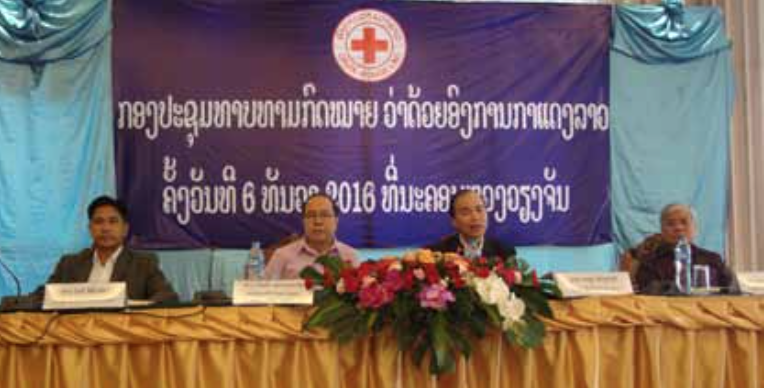Determining the right position, obligations and role of the Lao Red Cross will ensure the humanitarian organisation is able to serve the needs of the Lao people and bring them the greatest benefits.
This issue was noted by top LRC leaders as the central focus of discussions on the draft Law on the Lao Red Cross at a meeting held yesterday in Vientiane.
The meeting aimed to facilitate final discussions on the draft law and achieve consensus before it is submitted to the government for consideration and approval.
The LRC has been working for humanitarian purposes and benefited Lao people for 60 years but it has lacked a strong legal structure to ensure its continued development and the greatest benefits for the people .
A strong regulatory structure is especially necessary for a relief and disaster organisation in Laos as a least developed country which often faces natural disasters.
In deliberation on the draft law, LRC President Mr Khamhoung Heuangvongsy reminded the participants, who included officials from the Ministry of Justice, Ministry of Labour and Social Welfare (MOLS), Ministry of Health (MOH), and lawyers about the position, which he said is still unclear.
He told the meeting that since it was established 60 years ago, the organisation has moved around from one government agency to another, from the MOH to the Government Office, from the Government Office to the MOLS.
This situation has interrupted the continuation of the organisation’s development, and had impacts on those working for it, Mr Khamhoung said.
He confirmed that despite the LRC having a political philosophy which links with the Party and government, it works independently under the international convention, and the seven fundamental principles of the International Red Cross and Red Crescent Movement.
However, Mr Khamhoung said, the way the LRC would be defined by the upcoming law was under international observation.
The LRC has four technical units, which have 97 civil servants working at the central level, 290 civil servants working at the provincial level, and 187 civil servants working at its districts offices.
According to Mr Khamhoung, the LRC relies on the government budget only for salaries and other allowances, while all its activities have been implemented via domestic and international support.
If the LRC becomes too government-oriented, it will not receive sufficient support from the international community, he said.
Meanwhile, Mr Khamhoung spoke about the Red Cross organisations in countries where communist parties are ruling, including the countries of the former Soviet Union in central Asia, saying they are almost entirely dependent on their governments.
He pointed to the Red Cross in Vietnam as an example of a successful humanitarian organisation, saying it could mobilise support from a broad cross section of the public.
This 72-article draft law on the Lao Red Cross defines the humanitarian organisation as a civil society organisation of the Lao PDR, which works independently under the Party’s direction, constitution and laws of the country, international conventions, and the seven fundamental principles of the International Red Cross and Red Crescent Movement on humanity, which the country is a party to.
The last paragraph in the draft states any stipulations contradicting this law, are canceled.
Source: Vientiane Times



